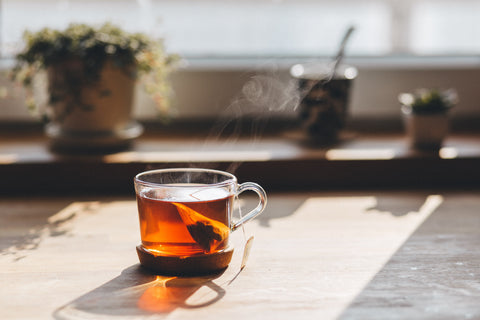The Perfect Preparation Guide
Drinking tea is one of the many ways in which you can invest in your well-being. From lowering inflammation to improving your digestive system to simply boosting hydration (links to benefits article), the benefits of enjoying a soothing, warm cup of tea have been documented for centuries (link to history post).
It is no surprise then that we would want to maximize our tea. For example, indulging in a dreamy cup of chamomile before bedtime could help send you into the kind of deep sleep that you only...well...dream of. Or saving your favorite Earl Grey for the morning could provide the caffeine boost that your day needs. Like anything that you consume, there are ways to help your body out and set yourself up for success.
One of the most overlooked aspects of tea is the actual process of preparing it. The truth is that properly steeping your tea is one of the first and most effective things that you can do to make sure you are enjoying all of the benefits that your leaves have to offer.

Green Tea
As discussed in our post about the six different types of tea (link to previous), green tea is the closest thing to picking tea leaves right from the plant and placing them directly in water. Assuming that the leaves are stored correctly (link to other blog “How to store your tea”) to ensure minimal oxidizing, the next step is determining how to extract all of that natural goodness without diminishing its healing properties. The key is in the time and the temperature. For a more delicate tea like this one, it is recommended to steep it at a lower temperature between 165 and 170 degrees Fahrenheit (http://www.antioxidants-for-health-and-longevity.com/how-to-brew-green-tea.html). If you find yourself without a thermometer handy, know that water boils at 212 degrees Fahrenheit, so you will want to let your boiling water cool for a few minutes before steeping your tea. Because it is at a lower temperature, the steeping process will be slightly prolonged at somewhere between two and four minutes. Taking account of these two important factors will help to preserve both the herbal flavors of your green tea, while giving you all of the antioxidants that help to purify your body.

Black Tea
Due to its higher oxidation and overall resiliency, black tea is one of the most popular teas in Western culture and can be shipped larger distances while maintaining its overall freshness and flavor. Because of this, black tea may have set the standard for how most Americans steep any kind of tea: boil the water, immediately pour it over your black tea bag or tea leaves, and wait a few minutes before enjoying. Since it is less delicate than lighter green and white teas, black tea should be steeped in boiling water at a temperature as close to 212 degrees Fahrenheit as possible. Furthermore, its steeping time is slightly longer than its green counterpart, and requires between three and five minutes before being able to really take in the caffeine content and benefits.

What about those herbal teas?
While there may be slight variations depending upon the herbs you are using, the main thing to know about herbal teas is that they are not derived from the same plant as traditional teas. This means that they can (and should) generally be steeped for much longer to make sure that not only are you maximizing the health properties of the leaves, but that you are also enjoying the lovely array of aromatics that different herbs have to offer. Some even recommend covering your cup as you steep your herbal infusion to make sure that all of the aromas and essential oils remain fully intact. Herbal teas should be steeped at least for five minutes and should be treated closer to green tea than to black as far as keeping the temperatures below boiling. And since herbal teas do not contain the tannins that actual tea leaves do, it is perfectly fine to let them steep far beyond the five minutes just as long as the flavor is still appealing to you.
Steeping time and temperature are essential to maximizing the benefits of your daily tea ritual. If you are drinking white or oolong teas, you simply have to remember that the lighter and more delicate the tea leaves, the cooler the water and shorter the steeping time. A good rule of thumb for steeping any kind of tea is to keep the time between three and five minutes, with the dark and robust leaves landing on the longer end of the spectrum. As for flavor, play around with the time and temperatures to find that sweet spot that works best for you. Then feel free to share your discoveries with us in the comment section below!
